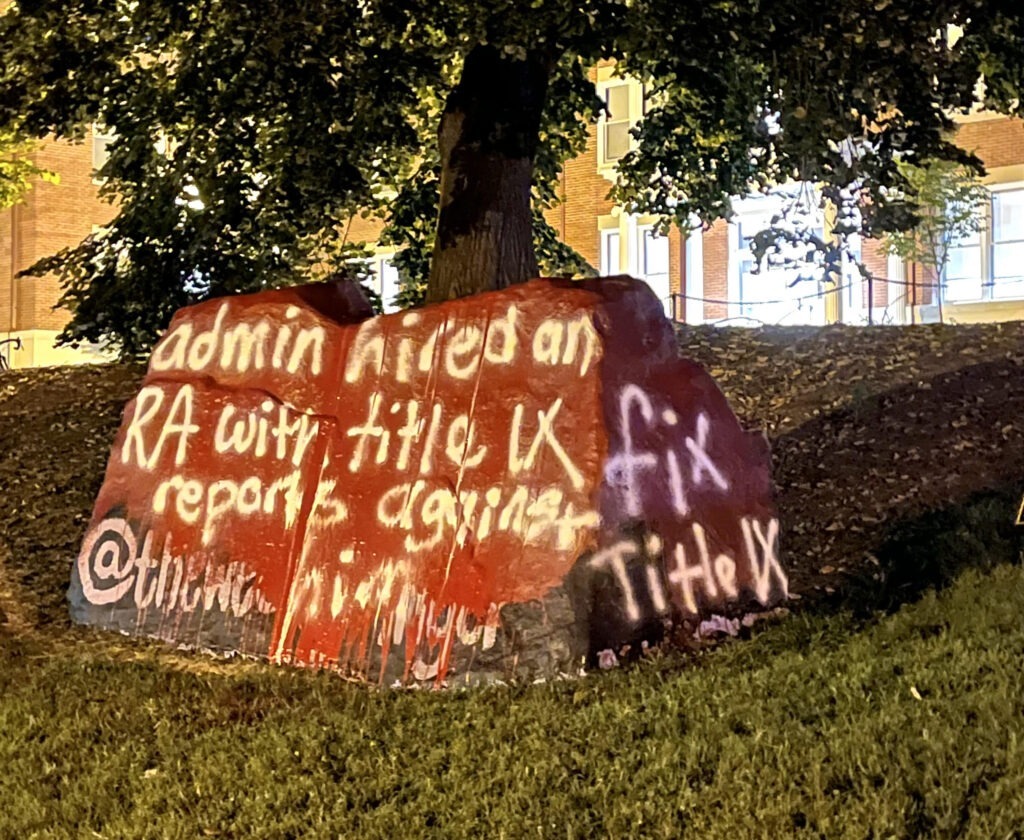“I don’t want this– I want to heal”: Students’ reactions to the spirit rock painting regarding Title IX
6 min read
The Spirit Rock was painted calling to “fix Title IX” between Saturday night and early Sunday morning. | Photo Courtesy of Erin Hassall
JESS KIRBY
Editor-In-Chief
This past weekend, UMW’s spirit rock was painted four times in approximately 48 hours. The rock called attention to students’ concerns that a Resident Assistant hired for the current school year had two previous Title IX complaints. The student is no longer an RA.
In recent years, the rock’s use has expanded beyond advertising events and spreading school spirit; the rock has become a massive message board—a way for students to call attention to safety concerns on a platform no one walking by can miss.
The rock was painted on Friday by The Weekly Ringer, advertising the newspaper’s first issue of the semester. It was then painted red on Saturday night with a white spray-painted message: “Admin hired an RA with Title IX reports against him. Fix Title IX.” Just a few hours later, the message was covered by smeared paint. By Sunday morning, a new message was etched into the wet paint saying “don’t cover it up” and mentioning the first name of the former RA. The rock was painted again early Monday morning to honor sexual assault survivors.
Recent Title IX case
According to the former RA, he has been through the Title IX process twice with two separate complaints, the first of which was filed in January and the second was filed in April. The name of the former RA, the name of the student who filed a Title IX complaint against him in April and the details of the case have been withheld while The Weekly Ringer gathers additional information.
According to Dean of Residence Life and Housing David Fleming, “The selection process for Resident Assistants includes a prior conduct check (OSCAR, Title IX, and Honor).”
Both Title IX cases that the former RA was involved in ended in informal resolution, the former RA said. According to UMW’s Policy on Sexual and Gender-Based Harassment and Other Forms of Interpersonal Violence, “In cases in which a formal complaint has been filed, prior to reaching a determination regarding responsibility, the parties may voluntarily and in writing consent to an informal resolution process facilitated by an informal resolution facilitator(s) under this Policy that does not involve a full investigation and adjudication.” The complainant and accused may agree to an informal resolution at any time before the final determination of responsibility is made. Once the two parties reach an agreement, the case is closed and cannot be appealed.
In the Title IX case against the former RA that began in April, the Title IX process continued into the summer before ending in an informal resolution. The informal resolution included a no-contact order, both he and the student who accused him said. They also confirmed that he was required to complete an online training course about sexual misconduct prevention and UMW’s Policy on Sexual and Gender-Based Harassment and Other Forms of Interpersonal Violence.
Reactions to the rock
On Saturday night, when the student who filed the Title IX complaint against the former RA in April saw the rock, she was taken aback by it.
“At first when I first saw it I was like, ‘Oh, my story’s being told,’” she said. “And then it dawned on me, ‘Wait, who did I tell? No one told me they were doing this.’ And also ‘Oh my God, he’s gonna see it.’ And that terrified me.”
When the former RA’s name was put on the rock, people reached out to the complainant, wondering if she had painted the rock. She hadn’t, and she did not agree with people using her story for their own purposes.
“I’ve been in that rageful state, and then this is another victim or someone who’s close to another victim that has happened since me that I don’t know about,” she said. “I can see the pain. You can see it in the way it’s etched in. You can see it in the colors. You can see that there was pain behind the statement. But this pain is not something that I think everyone has to know about. And we can have the message of ‘We need to fix Title IX’ because I am not going to sit here and say that Title IX handled everything with me accordingly and made me feel comfortable or safe. I am not going to say that, but I don’t want my experience and what happened to me used as a political weapon.”
The former RA didn’t hear about the rock until Sunday afternoon when he got a call saying his name was etched into it.
“Politely, I wish that people would stop talking about me so much and leave the business between myself and the complainants,” he said. “I don’t like how public my life has become. … And I know that there’s no turning back from that.”
When sophomore biology major Caleb Ruble saw the rock with the message carved into it, he was “horrified.”
“It looked like violence,” he said. “It almost looked like they were using it as an excuse to be violent. … Looking at this rock scared me.”
Ruble, who used to be friends with the former RA, does not believe the rock painting was a productive way of making change and said it put a target on the backs of those who filed Title IX complaints against the former RA. He also worried that it might drive the accused student to violence.
“I think with what our campus is kind of doing right now, this can drive anyone to become dangerous because what it feels like it’s become is everyone is now setting him into a corner. I understand,” said Ruble. “He messed up, and I understand he did many many terrible things. But no human deserves to be treated like a wild animal.”
To cover the message drawn into the smeared paint, early on Monday morning, Ruble and his friends painted the rock once more. The rock is now teal with purple writing saying, “Survivors: we see you; we are here for you.” They chose these colors on purpose, as teal symbolizes sexual assault survivors and purple symbolizes domestic abuse survivors. “Fix Title IX” was added later by someone else.
Ava Spencer, a senior earth and environmental sciences major, is a peer mentor on campus. She and her fellow peer mentors have been unsure if they should warn their peer mentees about a safety concern relating to the former RA.
“You don’t want to cause panic, but also as a woman, I’m inclined to say, ‘Yeah, you should warn your peer mentees about that,’” said Spencer. “But it’s also like there’s a line of where does this become like a manhunt or where does this become like rumors mongering kind of thing? And it’s hard to, like I said, sort of differentiate what is real and what isn’t.”
Spencer also compared the recent rock paintings to one from last fall that read, “Mr. Paino, how many reports to catch a few predators?”
Simon Jones, a senior economics major, believes that painting the rock about sexual assault can be harmful.
“It’s extremely triggering for a lot of people and generally doesn’t get anything done,” he said. “I don’t really think the vigilante justice system is really the answer to a broken Title IX system. I think it is not really fair to the victims either that it’s publicized as well.”
Ruble believes the best way to make change is not to identify the problem but to work towards a solution.
“I actually plan on starting to create a petition to see if I can’t help the Title IX office in some way and see if I can’t give it some kind of power or some kind of funding to be able to really help survivors and really see if we can actually get some punishment for those who have done things wrong,” he said. “Because at this point, I think that most people see Title IX for what it is now as more of a slap on the wrist and more of a like annoyance than it is an actual consequence.”
After the consequences of the rock paintings, many wonder what role the rock should play on UMW’s campus.
“I don’t want this—I want to heal,” said the complainant about the rock painting.
Scotti Mullen contributed to reporting for this article.


